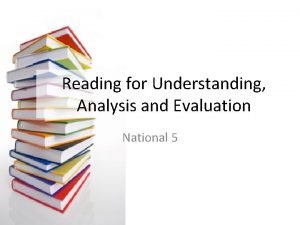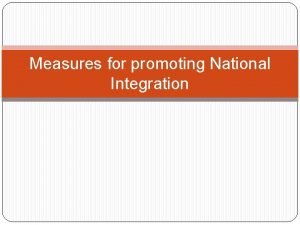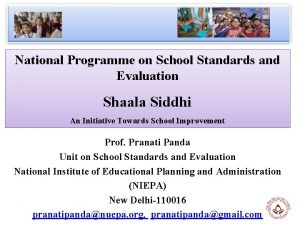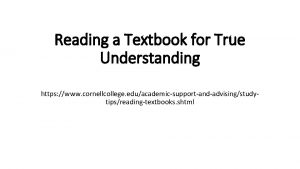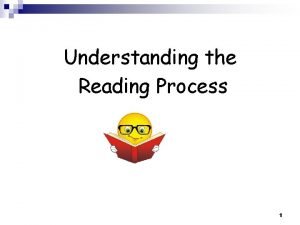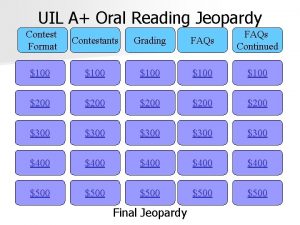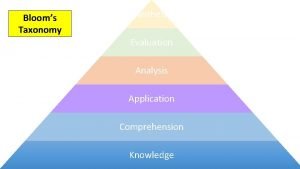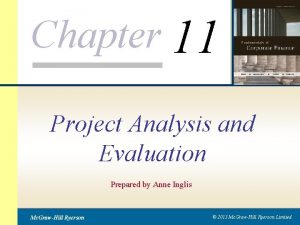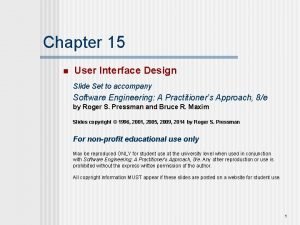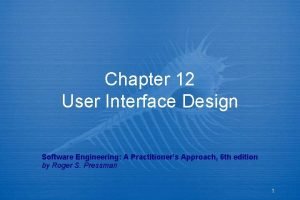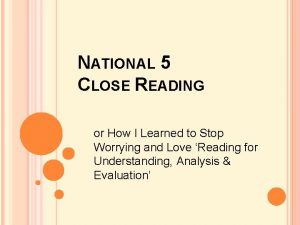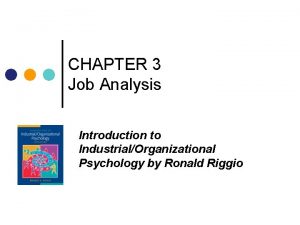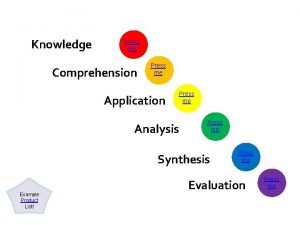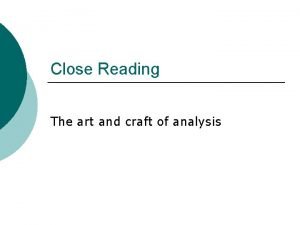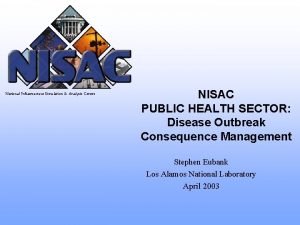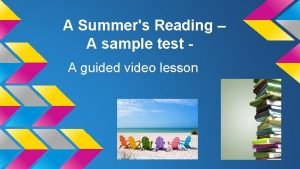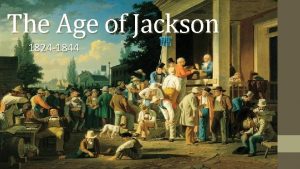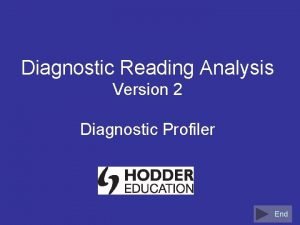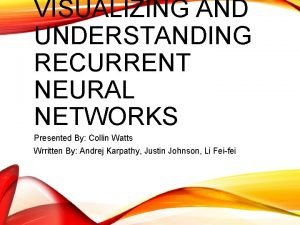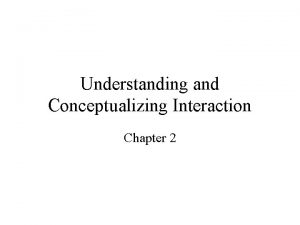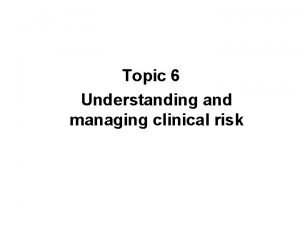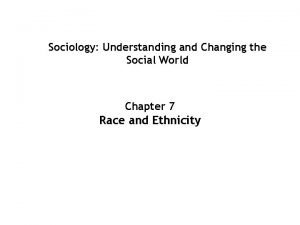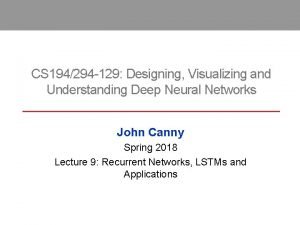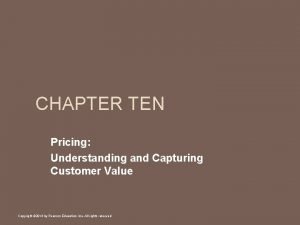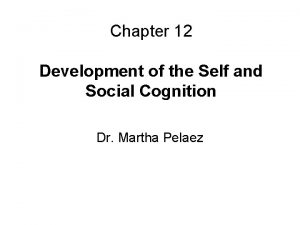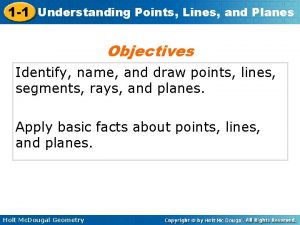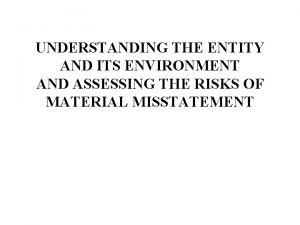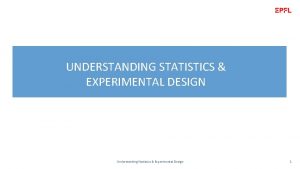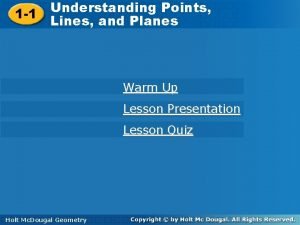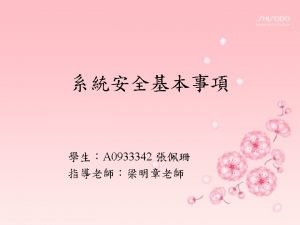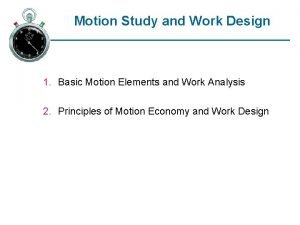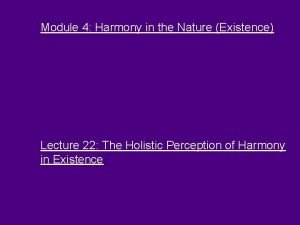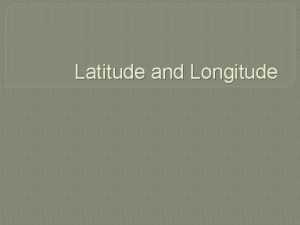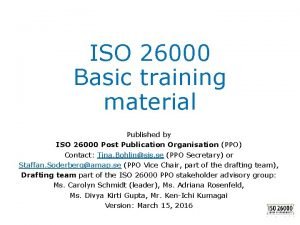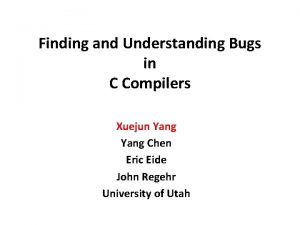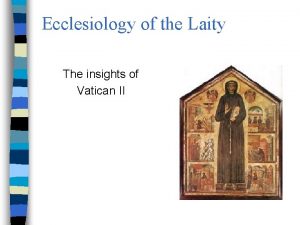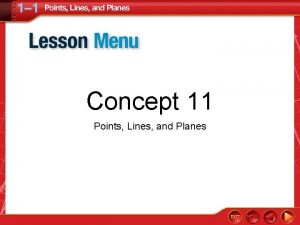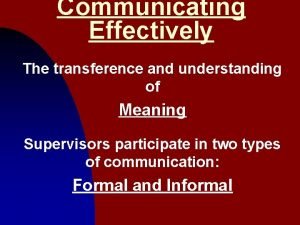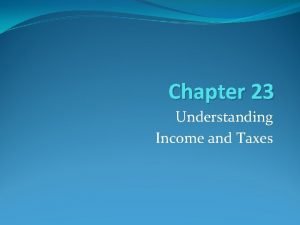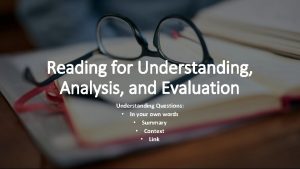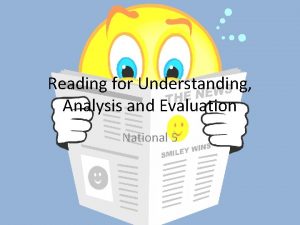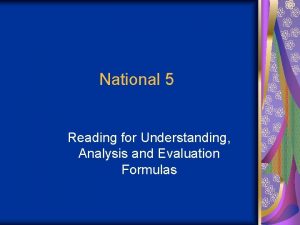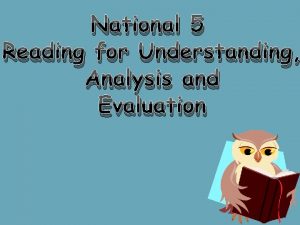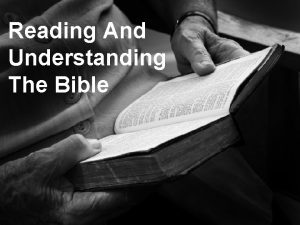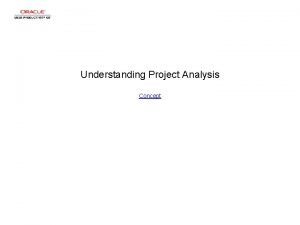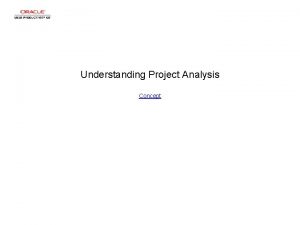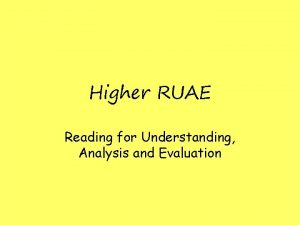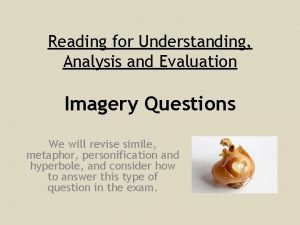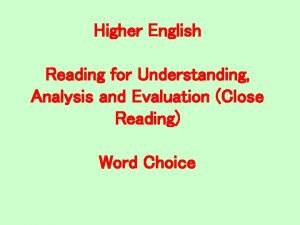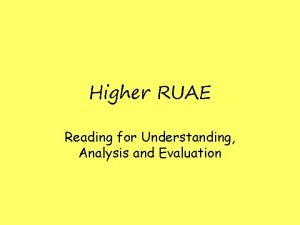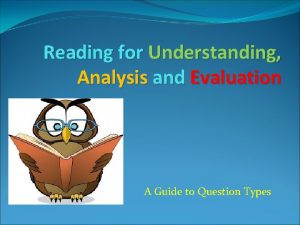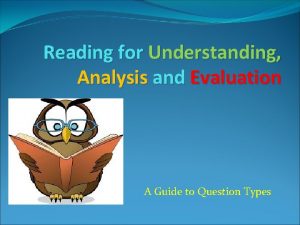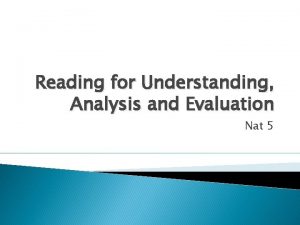NATIONAL 5 Reading for Understanding Analysis and Evaluation





































































































































- Slides: 133

NATIONAL 5 Reading for Understanding, Analysis and Evaluation Exam

Section ACONTENTS - Understanding Questions � � � � In Your Own Words questions Context questions Effective Conclusion questions Section B - Analysis Questions Writer’s Language Word Choice Imagery Sentence Structure questions Punctuation questions

Introduction to National 5 �This Power. Point is designed to help you improve your ability to understand the writer’s ideas, and to analyse and evaluate the language he/she uses to put those ideas across (Also known as ‘Close Reading’). �You will be given a non-fiction passage, perhaps a piece of journalism or an extract from a book. �It will be written in the ‘detailed’ language you have come to expect at National 5 �The exam lasts for 1 hr. You will be given a passage to read and a set of questions to answer on the passage.

To begin: �You should read through the passage twice carefully. If you are not a fast reader then you could read through the passage once thoroughly and then when a question asks you to look at a certain paragraph make sure that you read that paragraph again. �You should then have a quick skim through the questions before you begin. If you feel that you do not have time to do this then you should at least skim through the questions page by page as you come to them.

� Read the questions very carefully and ensure that you know what you are being asked to do before you begin. � Check for bold type in the question. This is very important as information / instructions in bold type highlight important sections of the question. � The passage will direct you to look at certain paragraphs – in bold type. Only take your answer from that paragraph. If you take from any other you will lose marks. � Identify key words in the question – eg. quote, write down, one word etc. � Check whether answers are worth (2, 3, 4) or even (5) marks. � Quote from the passage if asked to, otherwise, use your own words. This is very important! Easy marks are often lost because candidates do not follow instructions. ALWAYS QUOTE when directed to do so and ALWAYS USE YOUR OWN WORDS if instructed.


Section A: UNDERSTANDING

Section A: UNDERSTANDING QUESTIONS 1. In Your Own Words Questions 2. Context Questions 3. Effective Conclusion

IN YOUR OWN WORDS QUESTIONS. �Unless you are sure you are being asked to quote, you should always answer in your own words. �This is the only way to show that you really understand what the writer is saying.

: �When you read this you know that the answer is right there in the paragraph you are told to look at. �You only have to look carefully at the lines or paragraphs you are told to look at, find the answer/line/idea and put it into your own words �These questions are testing your vocabulary. �You must say the same thing, but use other words to do so. You are not translating though. Think about the whole idea – not individual words.

OWN WORDS QUESTION BREAKDOWN � Before you write your answer, you must take note of the number of marks available. For two marks, it is likely you will need to supply two pieces of information, but alternatively you might be required to give one detailed piece or four brief pieces. � It will be necessary for you to consider the wording of the question carefully for guidance. Occasionally, direct guidance may not be given and in this case you must use your common sense. � Obviously, one brief piece of information will be inadequate for a four mark question; conversely, providing a ten line answer for a one mark question is unwise as you will waste valuable time.

B) Purpose & Audience CONTENTS

Indeed… � To pass the unit assessments in National 4 and 5 Reading and Listening, you need to be able to identify the purpose and audience of texts produced by someone else. � To pass the unit assessments in National 5 Writing and Talking, what you write or what you say must fit your given purpose and be right for your target audience. � So basically: � Purpose means WHAT a text is for — why somebody said it, or wrote it. � Audience means WHO a text is for — who is supposed to read it or listen to it.

Purpose & Audience �Before we look at particular questions we are going to look at two linked ideas that are highly important in the National 5 course: �purpose and audience. �Although you are only asked explicitly about purpose and audience in the internal reading assessment and not the reading exam it makes sense to work on these now. �The easiest way to understand them is by seeing how they come up in what we read or listen to. Note too that these ideas also apply to what we write or say.

Audience Who is the writer aiming at with this passage? (who has it been written for? ) Most of the texts you will read will be written for a general adult reader but you should consider the following: �Various age groups, e. g. children, teenagers, senior citizens �Profession, e. g. doctors �People who have a specialist interest(experts) or hobby involving the topic, e. g. birdwatchers

When you answer you should use the formula below: � You should show you can identify and explain the audience of the article with clear justification, for example: � Use this structure for your analysis: � 1) Name the audience � 2) give evidence of the factual detail (a quote and/or a piece of info from the text) to support your choice � 3) Explain how your choice of evidence supports you choice of audience.

For example… �Here are some model questions: � 1) Who would be likely to read this article? � Explain how you reached this conclusion. You could consider age, interests, gender, background and so on. � 2) Most authors want to do more than simply tell a story. They also want to appeal to a particular audience. � a Identify readers who you think would enjoy this text, suggesting a key theme that they would be interested in. � 3) With close reference to the text, give evidence for your view. � (a) Who would be likely to read this poem? Think about: � � Age and/or Interests and/or Nationality and/or Another audience you can identify � (b) Explain how you reached this conclusion.

Purpose A writer sets out with a purpose for his piece of writing. He could be trying to just encourage us to read or his purpose could be more specific: �To give information about a topic �To entertain �To explain �To persuade �To express feelings/ a viewpoint about something �To share and experience �To disagree with something �To comment on a topic

When you answer you should use the formula below: � You should show you can identify and explain the purpose of the article with clear justification, for example: � Use this structure for your analysis: � 1) Name the purpose � 2) Give evidence of the features typical of that type of writing (a quote and/or a piece of info from the text ) to support your choice. For example: �Inform – statistics/facts… �persuade – emotive/conversational language… �entertain - humour, irony… � 3) Explain how your choice of evidence supports you choice of purpose .

For example… �Here is a model question: � 1) What is the purpose of the article and explain how you reached this conclusion. �Support your answer with evidence from the text

Using your own words means you may have to: �A) Explain what a word or expression in the passage means �B) Explain the main point the writer is making �C) Give the reason for something that happens in the passage �D) Show that you understand a piece of information the passage gives

Worked Example…. �The topic of this text was ‘a notorious species of spider’, the tarantula, and the narrator was the spider itself. �‘I’m nocturnal. I love the moonlight, the shadows, the dark places, the dappled murk. I’m not being poetic. I’m simply being true to my nature, my nocturnal nature. Like all tarantulas. ’ �Question: In your own words, in what way is the speaker ‘like all tarantulas’ according to the first paragraph? (1 Mark)

There are two steps to answering a question of this type. �Step One: �Look in the text for the information which will answer the question. In this case, it is provided by the word ‘nocturnal’. �Step Two: �Express the information in your own words in a simple sentence which fits the way the question is worded. In this example you had to change from 1 st person (‘I’) into 3 rd person (‘the speaker’). �An acceptable answer to gain the mark would be: �‘The speaker is active by night. ’ �Remember, if you were simply to say ‘The speaker is nocturnal’ or ‘He is nocturnal’ you would get no marks since you would have failed to do step two, namely to use your own words.

Answer the following questions, using your own words as far as possible, to show your understanding. The number of marks available for each question suggests how many details or ideas you need in each answer.

Model Example 1 � Having beaten 200 applicants to the job, she believes she has proved herself to be the best candidate. ‘Sometimes I feel people think I should be grateful that I have a job but I’m performing a useful task and doing it well, so they should be grateful to me, ’ she said. ‘After ail, they wanted me badly enough to employ me a month before I had finished my degree. ’ � Question - Penny Andrews ‘believes she has proved herself to be the best candidate’. In your own words, explain how paragraph 9 illustrates this idea. 2 � Answer – Candidates should demonstrate an understanding of Penny Andrews’ qualities and/her employers desire to hire her. � She beat 200 other candidates/She performs a useful task/She does this task well/She was employed a month before finishing her degree. � Any two.

Model Example 2 � 10 Far from feeling that her diagnosis of Asperger ‘s is something to be ‘got over’, Andrews maintains it gave her a lead over the other candidates. ‘I’m more focused, intense and honest than a neuro typical person, ’ she said. ‘I do things thoroughly and pay proper attention to detail. I’m always switched on: even when I’m not at work, I’ll go to events that are relevant. Libraries are one of my autistic specialities and I harness that at work. ’ � Question - What are some of the advantages for companies who hire members of staff with autism? Refer to paragraph 10 in your answer, using your own words. 4 � Answer - Candidates should demonstrate an understanding of hiring staff with autism. Any four ideas for 1 mark each. � At least some attempt at own words gloss of: � ‘focused’/‘intense’/‘honest’/‘do things thoroughly’/‘pay proper attention to detail’/‘always switched on’.

Model Example 3 � 11 Employers’ attitudes might be changing but there is a lot 15% of those with autism have full time jobs, according to research by the National Autistic Society (NAS), while 9% work part time. More than a quarter of graduates with autism are unemployed, the highest rate of any disability group. Nevertheless, employers are increasingly coming round to the arguments that employing those on the spectrum is not about charity or social responsibility but about the empirical benefit of taking on people with unique skills. � Question - In your own words, explain in what ways ‘there is a lot of ground to make up’ for people with autism in the workplace. Give evidence from paragraph 11 to support your answer. 3 � Answer - Candidates should demonstrate an understanding of the extent to which people with autism are still under-represented or disadvantaged in the workplace. Any three ideas for 1 mark each. At least some attempt at own words gloss of: � ‘Just 15% of those with autism have full time jobs’/‘ 9% work part time’/‘More than a quarter of graduates with autism are unemployed’/Unemployment among graduates with autism is at ‘the highest rate of any disability group’.

For practice… Task Look at these words and phrases you might find in questions. Which expressions tell you that you ought to quote in your answer and which ones suggest you write in your own words? � Why do you think…? � Which word…? � Explain fully…? � Find an expression…? � How does the writer…? � Write down the word…? � Which expression…? � By close reference to the text…. ?

ANSWERS… � The phrases that tell you that you must quote in your answers are: � Which word…? � Find an expression…? � How does the writer…? � Write down the word…? � Which expression…? � The phrases that suggest that you write in your own words are: � By close reference to the text…. ? � Why do you think…? � Explain fully…?

Context questions CONTENTS

CONTEXT QUESTIONS �You may be asked to show the context, that is the words or phrases around an unusual word, that give us an idea of what an unfamiliar word may mean. �For Example: �Show the first sentence provides a context which enables you to understand the meaning of the word’. . . �Explain in your own words what is meant by ‘______ in this context �How does the context of lines xx xx help you work out what is meant by ‘_____’? �Work out from the context what is meant by ‘_____’ in line xx.

CONTEXT QUESTION BREAKDOWN �If the context question is worth 2 marks, you will generally be awarded if follow the formula below: �A) 1 mark for getting the meaning right and �B) 1 mark for the quoted piece of evidence with a brief explanation. �It is usually possible and advisable to quote two pieces of evidence and it is essential if the question is worth a total of 3 marks.

For example…. �Look at this example: �“He lay there XXX , blood seeping from a head wound and his jaw cracked like a walnut. ” �You can guess that XXX will mean “injured” or “damaged” or something like this. �You have guessed by using the context to help you reach an understanding.

WORKED EXAMPLE �Here is a worked example: �The rumour that Douglas was a prisoner was still unsubstantiated. There had been no witnesses to his bailing out of the plane, and no solid information could be expected from beyond enemy lines for weeks, perhaps even months. �Question: �‘Show the context helped you arrive at the meaning of the word unsubstantiated. ’ � 2 marks

Answer �A) The word “unsubstantiated” clearly means unconfirmed. (1 mark) �B i) The context makes this clear as it says there were “no witnesses” who could say for sure the news was true ( ½ mark), �B ii) and the phrase “no solid information” also repeats the idea of there being no firm proof. ( ½ mark)

Model Example 1 � At Guy’s and St Thomas’ hospitals in London, an initiative was set up two years ago to help people aged 18 to 30 with autism gain work experience. � Staynton Brown, associate director of equality and diversity at the hospital, dismisses any suggestion of the initiative being a philanthropic one. ‘This is not a charitable gesture, ’ he said. ‘We want to make sure we have the most talented workforce possible. It’s in our interests in multiple ways. We’ve all benefited from the changes we’ve incorporated to accommodate those with autism. By clarifying the way we give information to and help introduce the interns into the hospital, we’ve made communication clearer for everyone, which leads to better patient care. ’ � Question - 1. How does the context of the second paragraph help you to work out what is meant by ‘philanthropic’? � Answer - Candidates should demonstrate understanding of the meaning of the word and provide contextual evidence of how they arrived at this for 1 + 1 marks. � Answer - Meaning: The word ‘philanthropic’ as used here means done out of feelings of charity or so. Iely for the good of others. � Context: I can work this out from the context because the expression is followed with the idea that employing people with autism is not ‘charitable’.

Model Example 2 � At Guy’s and St Thomas’ hospitals in London, an initiative was set up two years ago to help people aged 18 to 30 with autism gain work experience. � Staynton Brown, associate director of equality and diversity at the hospital, dismisses any suggestion of the initiative being a philanthropic one. ‘This is not a charitable gesture, ’ he said. ‘We want to make sure we have the most talented workforce possible. It’s in our interests in multiple ways. We’ve all benefited from the changes we’ve incorporated to accommodate those with autism. By clarifying the way we give information to and help introduce the interns into the hospital, we’ve made communication clearer for everyone, which leads to better patient care. ’ � Question - Show the context helps you to understand the meaning of the word ‘accommodate’ as it is used here. 2 � Answer - Meaning: to make allowances/adjustments for someone/to make it easier for someone to settle in etc. � Context: reference to idea of, or explanation of details of, changes made to accommodate staff with autism.

Model Example 3 � At Guy’s and St Thomas’ hospitals in London, an initiative was set up two years ago to help people aged 18 to 30 with autism gain work experience. � Staynton Brown, associate director of equality and diversity at the hospital, dismisses any suggestion of the initiative being a philanthropic one. ‘This is not a charitable gesture, ’ he said. ‘We want to make sure we have the most talented workforce possible. It’s in our interests in multiple ways. We’ve all benefited from the changes we’ve incorporated to accommodate those with autism. By clarifying the way we give information to and help introduce the interns into the hospital, we’ve made communication clearer for everyone, which leads to better patient care. ’ � Question - How does the context of these paragraphs help you to understand the word ‘intern’ as it is used there? 2 � Answer - Meaning: person working to get experience (rather than for a wage). � Context: reference to or quotation of ‘work experience’ in paragraph 1.

Contrast questions CONTENTS

Contrast questions �Contrast is the pairing of opposing ideas �A contrast is a comparison which shows up the differences between subjects. �The writer is deliberately pairing two ideas together to show up the difference which will be important in some way.

For Example… �In “Romeo and Juliet”, Shakespeare continually compares Juliet to the sun or to a star. §The idea he is conveying is that she is above everyone around her. §Everyone else is dark by comparison and she brings light into Romeo’s life.

Example 1993 General paper “On the 24 th of June 1914 William Maitland walked into a house and never came out again. One summer afternoon in Millhall, Lancashire, he vanished from the face of the earth. It was as simple, and as complicated, as that. ” • Question: Explain the contrast the writer conveys in these lines. HINT: The answer lies in the contrast presented in the last sentence where we are told it was “SIMPLE” and also” COMPLICATED”. - So the contrast is in these two opposing ideas. Answer: The contrast is in how easy it is to understand what happened but also how difficult it is to explain what happened.

Summary Question CONTENTS

Summary Question �One key skill the examiners want you to have is the ability to follow, and summarise, a key idea or line of thought running throughout an article or passage. �You can expect that the final question in the exam paper will test your ability to do this.

Look at this newspaper article � READ THE NEWSPAPER ARTICLE BELOW: � ‘In praise of. . . Elizabeth, the Bond girl � Miranda Frost, Vesper Lynd and now. . . Elizabeth Windsor. ‘No, it can’t be, ’ cried a nation in unison, after a screen in the Olympic stadium revealed an elderly lady interrupt her letter writing to greet Daniel Craig’s James Bond with a very familiar face. It couldn’t be her since we all know that becoming a Bond girl is simply not the sort of thing Her Majesty does. Yet Elizabeth Windsor it was — and she was wearing the same costume she had worn on the film set for the big night out. That enabled stuntman, smoke and mirrors to suggest she was being hoisted into Stratford by helicopter. This was the moment which — ahem — crowned Danny Boyle’s triumph, since even republican Olympophobes had to admit this was something they’d not seen before. It also enabled a Diamond Queen to reveal a sense of humour hitherto hidden during her 60 year reign. Secure in her jubilee popularity, let’s hope she dares to share it again’. You Tube Link James Bond Source: The Guardian, 29 July 2012 escorts The Queen to the opening ceremony London 2012 Olympic Games BBC

What are the writer’s main ideas? � Let’s look at what the article contains and try to strip it down to main ideas, summarising as we go: � 1) A list of Bond girls; the Queen is added to that list. � 2) A description and explanation of the section in the Olympic opening ceremony that featured the Queen and Daniel Craig (as James Bond). � 3) A statement that this unexpected and funny segment was perhaps the highlight of the show. � 4) An observation that the fact that the Queen showed a sense of humour is a good thing.

So, roughly, there are four areas of content in the article. �What are the main ideas? �Looking at the previous slide, you will see that: � 1) bullet point 1 is a list, � 2) number 2 is a description and explanation. � 3) That leaves points 3 and 4, which make up the main points of the article. �Often a way of finding the main points of a piece of writing is to take out the descriptions, explanations and examples. �Having done this you are left with the main points. �Strip away the non essentials and you are left with the essentials.



For Example… �Question - Referring to the whole article, both the main section and the later, short extract list in your own words the key advantages for employers in hiring staff who have autism. 4 � HINT: None of the details in your answer should be specific to just one employer or one employee. � All the given details should be general advantages that any employers might find in hiring a person who has autism. � As the question asks you to list the advantages, it is a good idea to present your answer as a series of bullet points. � This will help you to keep track of ideas and to make sure you have given four answers.

Answer… � Candidates should summarise the advantages of hiring people with autism, according to the article. Any four points from the Additional guidance column (may be in bullet point form or in continuous prose). � � � � Key points: They are very focused on their work/they concentrate well. They are honest. They work thoroughly. They pay attention to detail. They think about the job even when they are not at work. They have unique skills. Their skills bring a measurable benefit to their employers. They have good analytical skills. They will work even better if their job coincides with an area of specialist interest. They are good timekeepers. They are rarely off work. They are loyal They will enjoy jobs which others find boring. They are ideally suited for work in the service industry/work which is repetitive and structured.

Linking questions CONTENTS

Linking questions � A linking sentence is one which links two paragraphs together. � Usually this sentence will appear at the start of the second of the two paragraphs which are being linked. � Look carefully at the sentence which is the link. � There will be two parts to this sentence: � One part will refer to the content of the paragraph before. � The other part of the sentence will introduce the subject of the new paragraph.

When you answer you should use the formula below: � There is a simple, four step formula to tackling these types of questions: 1. Quote briefly from the linking sentence or paragraph. 2. Show that quotation makes a link back to earlier in the passage. 3. Quote briefly again from the linking sentence. 4. Show this second quotation makes a link forward to what is to come in the passage.

Worked Example…. �For example, a link question based on the news article about a teenage computer curfew might be worded like this: �How does the sentence ‘Needless to say, my efforts to explain this to my daughter were pretty hapless. ’ form a link between paragraphs 8 and 9? �To answer this, you need to reread this section of the passage:

Passage �‘Especially for girls, with their intimate, gossipy, social the drive to remain as connected as possible with friends is overwhelming. Yet perversely, floating in an electronic sea has the deeper effect of depriving them of the habit of being alone, developing their own thoughts. �Needless to say, my efforts to explain this to my daughter were pretty hapless. I dredged up the example of the hostage Terry Waite who got through years chained to a radiator in Beirut by the sheer strength of his interior life. My daughter listened politely, but her expression was incredulous. When was she ever going to be chained to a radiator in Beirut? ’

A good answer to this question would be: � 1) The expression ‘to explain this’ � 2) links back to the harmful effects of always being connected as discussed in paragraph 8. � 3) The expression ‘my efforts’ � 4) introduces the writer’s attempt to explain the value of having an interior life, which is discussed in paragraph 8.

Example: 2002 Credit Paper � The three witches in Macbeth, prancing cackling round their cauldron, provide the accepted clichés of witch behaviour and taste. Alas the Macbeth witches have merely served to reinforce prejudice, rather than cast illumination. So does the witch deserve her poor image? It is probable that the Wiccan creed goes back to the dawn of religious belief, when cave dwellers peered out and saw wonder in the rhythm of the changing seasons. Early witchcraft was probably no more than a primitive attempt to make sense of the unknown. Question: In what way can the single sentence be regarded as a link of the ideas within the article? Answer: 'Her poor image' refers back to the prejudiced ideas about witches mentioned already, such as those found in Macbeth. The question, 'Does the witch deserve. . . ? ' introduces the next part of the passage, which is going to present a truer history of witchcraft.

Model Example 2 � His father looked at the sweating horse, and after a pause he said that he would be alright. Howard could see he knew the berries weren't ready yet, like the ones behind the steading that they always picked; and he understood that this was a lesson being set up for him when he came home without brambles: not to tell lies. And there'd be another lesson behind this one, the real lesson: that his father had been right about that sort of new fangled nonsense coming to grief. In spite of this, he forgot it all and slipped through the racecourse fence. Question: Explain how the one sentence paragraph is an effective link between the paragraphs before and after. Answer: 'In spite of this' refers to the lessons of the first paragraph. '. . . through the Racecourse fence 'takes Howard in to the setting of the third paragraph. 1 mark for each quote + reference.

Section B: ANALYSIS CONTENTS

Introduction… �The most important thing to remember when tackling analysis questions is to make sure you are absolutely clear on what you are being asked to do. �Remember that in an Analysis question it is unlikely that you will be being asked merely to explain meaning.

Section B: Analysis Questions � 6) Writer’s Language � 7) Word Choice � 8) Imagery � 9) Structure � 10) Tone, Mood and Atmosphere CONTENTS

Writer’s Language CONTENTS

Writer’s Language �The Writer’s Language Question The instruction to look at the writer’s language and ‘Show how. . . ’, for example: �‘Show the writer’s language in lines x—y highlights the importance of. . . �In this last case there is no named technique or feature to guide you. �You must go through your own mental list of techniques and see which you can identify as being important, before you can start your answer.

You would probably consider the features below. �For example: � 7) Word Choice � 8) Imagery � 9) Structure � 10) Tone CONTENTS

Word choice questions CONTENTS

Denotation and Connotation �Of course, all words that a writer uses are chosen in some way, but when we talk about word choice as a technique, we mean that certain words are deliberately chosen to obtain particular effects or to suggest particular meanings. �Most words have two levels of meaning, a denotation and a more complex connotation �A). The denotation is the basic, simple, straightforward meaning. �B) The connotations of a word are the ideas that a word suggests to us.

For Example Words are chosen for effect – words can make you think of more than just their literal meaning. �Words have connotations. These are the associations we give to words, the ideas we are made to think of when we hear or read any given word. Lisbon 67 Rangers Ireland Seville 03 CELTIC FC Henrik Scotland §When a question asks you to comment on word choice think of the associations the identified word(s) will conjure up in a reader’s mind.

Another example… �Think of the ideas we associate with the word “butterfly”. �We think of delicate things, light, beauty, erratic flight, unpredictability, etc. �If the word is then used to describe a person these qualities are associated with that person.

Some advice on tackling these questions: § These questions are asking you to do two things: 1. First identify and write down the word/s which are being used for effect. 2. Then, explain what their effect is. The effect is what the word makes you think. • This phrase (“This suggests”) should appear in your answer. • When a question asks you to comment on word choice think of the associations the identified word(s) will conjure up in a reader’s mind.

When you answer you should use the formula below: �The word ". . X. . . " suggests that. . . �OR �". . . X. . . . " makes us think about. . .

Worked Example…. �The topic of this text was how Paraguayan landfill workers (gancheros) use the rubbish they recycle to make instruments for their children to play in a youth orchestra �They race towards a rubbish truck as it empties its load at a vast landfill on the edge of the city; hauling away bin liners that overflow with household waste. Their hands are black with dirt and their faces are hidden by headscarves that protect them from the high sun. �Q Explain how the writer’s word choice in paragraph 1 helps to show that the gancheros’ job is tiring. 2

Answer… �A The writer uses the word ‘hauling’ to describe them moving the bags of rubbish. �This suggests the bags are heavy or awkward to move, which would make this job exhausting.

Model Example 1 �Among the mounds of refuse, however, are used oven trays and paint pots. Cast aside by the 2 million residents of the capital of Paraguay, they are nonetheless highly valued by Nicolás Gómez, who picks them out to make violins, guitars and cellos. Gómez, 48, was a carpenter and ganchero but now works for Favio Chávez, the conductor of Paraguay’s one and only landfill orchestra. Question: 1 How does the word choice in paragraph 3 suggest that there is a lot of rubbish? 2 Answer: Candidates should quote an example of word choice for 1 mark and for a second mark explain how this creates the given effect. ‘mounds’ + explanation

Model Example 2 �The Cateura Orchestra of Recycled Instruments is made up of 30 schoolchildren — the sons and daughters of recyclers — whose instruments are forged from the city’s rubbish. And while its members learned to play amid the flies and stench of Cateura, they are now receiving worldwide acclaim, culminating earlier this month with a concert in Amsterdam. Question: 2 What does the word choice of paragraph 4 imply about the environment of the rubbish dump? 2 Answer: Candidates should quote an example of word choice for 1 mark and for a second mark explain how this creates the given effect. ‘flies’ and/or ‘stench’ and explanation

Model Example 3 �Gómez travels three times a week to Cateura to dig out material. He shapes the metal oven trays with an electric saw to form the body of a violin and engineers cellos from oil barrels. The necks of his string instruments are sculpted from old strips of wood, called palé. Question: 3 How does the word choice in paragraph 8 give the impression that Gómez is a skilled maker of musical instruments? 2 Answer: Candidates should quote an example of word choice for 1 mark and for a second mark explain how this creates the given effect. Any of ‘shapes’, ‘form’, ‘engineers’, ‘sculpted’ and explanation

Example 4: 2002 Credit Paper � The transaction seemed to fluster her, as if she might not have enough money to pay for the few things she'd bought. A tin of lentil soup. An individual chicken pie. One solitary tomato. Maybe she did need the avocados or something else. Question: How does the writer emphasise that the woman had bought 'few things' through the use of word choice? Answer: Use of a / an / one / individual / solitary (any two)

Example 5: 2001 Credit Paper The driver opened the back door of the taxi and my 'aunt', as we referred to her really my mother's aunt's daughter divested herself of the travelling rugs. She hazarded a foot out on to the gravel in a pointy crocodile shoe as if she were testing the atmosphere. She emerged dressed in a waisted black cashmere overcoat with a fur collar and strange scalloped black kid skin gloves like hawking gauntlets. Question: What impression of the aunt do you get from the writer's choice of the words 'divested', 'hazarded', and 'emerged' to describe her movements? Answer: She is controlled/ precise/ deliberate/calculating/ elegant/ contrived/graceful/ attention-seeking/ self conscious/a show off/ a poser Anyone for 2 marks

Example 6: 2004 Credit paper �He was breathing heavily and the smell was inconceivably foul; it was the reek of rotting flesh, of festering wounds, of ancient perspiration, and of fear. � Question: Explain fully how the writer emphasises the smell through word choice. � Answer: Inconceivably foul/reek of rotting flesh/festering wounds/ancient perspiration (1) + explanation (1) 2/1/0

Imagery Figures of speech CONTENTS

Figures ofthespeech These are simply various names given to the different ways in which a writer can make his or her work more interesting. Click on this link for a detailed guide to the different figures of speech you may be asked about. http//www. buzzin. net/english/figures. htm

Imagery Questions �Writers use images to strengthen what they say by putting all sorts of pictures in the reader’s mind. �Imagery is not the same thing as description. A description tells us what something is like. �An image shows that one thing is somehow like another. The comparison tells us more about the thing that is being compared. �Similes, metaphors and personification are all different sorts of image,

IMAGERY §A SIMILE tells you that one thing is like another; it compares two different objects using the words ‘like’ or ‘as’. e. g. His hair was as black as coal. His heart beat like a drum. §A METAPHOR tells you that one thing is something else. It is not meant literally, but is just a way of creating a vivid picture in your mind. e. g. The cold breeze was a slap in the face. She stared with eyes of stone. §PERSONIFICATION describes a thing or object as if it is a person, or as having human qualities. e. g. The wind whistled through the sails. The sun treads a path through the woods.

When you answer you should use the formula below: � There is a method for analysing images. � You begin with what the image literally is like, or literally means. Then you go on to the metaphorical meaning, showing how that image applies to and adds meaning to the subject under discussion. � Use this structure for your analysis: � 1) Explain the comparison � 2) Just as. . . (explain the literal meaning), � 3) So. . . (explain the metaphorical meaning).

For Example… � 1) He compares his work load to a mountain. �We could analyse the image like this: � 2) Just as a mountain is large and is challenging to climb, � 3) so the amount of work he has to do is enormous and will be really difficult.

Worked Example…. �‘Jonathan Young has big plans for his career. The business analyst at Goldman Sachs is on the autistic spectrum. But this, he says, is not something he allows to hold him back. �‘I’m the company’s global go to guy for all the information used in every single one of our presentations; he says. ‘I’m moving up the ladder every year in terms of responsibility or promotion. My ambition is to maintain this momentum. In 10 years, I want to be someone fairly big. ’ � Here’s an imagery question about this extract: �Look at the following image: ‘I’m moving up the ladder every single year. . . ‘. �Explain what this image means and its effect. 3

Answer �‘Jonathan Young compares his progress at work to climbing a ladder Just as climbing a ladder takes you higher, so Young is moving up and being promoted within the company. This shows how much progress he is making. ’ � The question is worth 3 marks, so the student did three things to answer it: � A She stated the comparison: ‘Jonathan Young compares his progress at work to climbing a ladder. ’ � B She analysed the image: ‘Just as climbing a ladder takes you higher, so Young is moving up and being promoted within the company � C She said what the image shows: ‘This shows how much progress Young is making:

Expected response �Full analysis of the image — 3 marks. �Clear analysis of the image — 2 marks. �Weak analysis of the image — 1 mark. �Misunderstanding of the image — 0 marks. �For 3 marks, candidates should state the comparison and show it is linked to the example used in the passage. �This would be considered a full analysis.

Model Example 1 � At 13, 1 would spend long vigils beside the home telephone every evening, calling the friends who I had seen all day at school to resume our conversation. Everyone did. It’s normal for teenagers to require constant interaction with their peer group, while other figures, like parents, vanish to the margins, and I saw nothing strange about spending hours crouched in our hall, discussing embarrassing teachers and hilarious friends in exhausting detail. Sometimes, an exasperated parent would wrench the phone out of my hand, forcing me to skulk back to my room. Question: 1 Look at the following image: ‘vanish to the margins’ (paragraph 1) Explain what the image means and analyse its effect. Answer: The writer compares the declining importance of parents to something being pushed to the margins. Just as the margins are at the edges, so parents are no longer central to their children’s lives. This shows that parents are less important to teenagers than friends are.

Model Example 2 � Our children, like most of their friends, are accessorised with both laptop and mobile phone. As a result, the potential for constant communication with their friends is ever present. Texting begins early morning and lets up last thing at night. Friends wake them up, friends say goodnight and Facebook fills all the gaps in between. The sweet, individualised ring tones that signify when a particular friend is texting beep from 6. 30 am to 11 pm, chirruping their insistent way through supper, homework, bath time and sleep. Technology embraces our children, like ourselves, in a warm electronic sea, and the tide of it comes ever higher. Question: 2 Look at the following image: ‘Technology embraces our children’ (paragraph 3) Explain what the image means and analyse its effect. Answer: The writer compares technology’s influence over children to an embrace. Just as an embrace is a close, enfolding hug, so technology has a tight hold of teenagers. This shows that technology is very important to teenagers.

Model Example 3 � Our children, like most of their friends, are accessorised with both laptop and mobile phone. As a result, the potential for constant communication with their friends is ever present. Texting begins early morning and lets up last thing at night. Friends wake them up, friends say goodnight and Facebook fills all the gaps in between. The sweet, individualised ring tones that signify when a particular friend is texting beep from 6. 30 am to 11 pm, chirruping their insistent way through supper, homework, bath time and sleep. Technology embraces our children, like ourselves, in a warm electronic sea, and the tide of it comes ever higher. Question: 3 Look at the following image: ‘a warm electronic sea’ (paragraph 3) Explain what the ¡mage means and analyse its effect. Answer: The writer compares electronic communication to the sea. Just as a swimmer has the sea all around them, so teenagers are surrounded on every side by technology. This shows that they are in danger of being overwhelmed by the technology in their lives.

Model Example 4 � Our children, like most of their friends, are accessorised with both laptop and mobile phone. As a result, the potential for constant communication with their friends is ever present. Texting begins early morning and lets up last thing at night. Friends wake them up, friends say goodnight and Facebook fills all the gaps in between. The sweet, individualised ring tones that signify when a particular friend is texting beep from 6. 30 am to 11 pm, chirruping their insistent way through supper, homework, bath time and sleep. Technology embraces our children, like ourselves, in a warm electronic sea, and the tide of it comes ever higher. Question: 4 Look at the following image: ‘the tide of it comes ever higher’ (paragraph 3) Explain what the image means and analyse its effect Answer: The writer compares technology to a rising tide. Just as a rising tide cannot be stopped, so the amount of technology in life keeps increasing. This shows we cannot stop technology coming into teenage lives.

Model Example 5 � Sue Palmer, in her new book, 21 st Century Girls, goes all out for total technological cold turkey ‘Allowing electronic strangers into a girl’s bedroom before her mid—teens is an extremely bad idea. If parents want their daughters to establish healthy sleeping habits they have to bite the bullet and insist that their bedroom remains a technology free zone Question: 5 Look at the following image: ‘Allowing electronic strangers into a girl’s bedroom. . . ‘ (paragraph 7) Explain what the image means and analyse its effect. Answer: The writer compares using technology in your bedroom to letting strangers in. Just as letting strangers into a girl’s bedroom would be dangerous and stupid, so letting her use technology in there is unwise and risky. This shows the risks of technology.

Model Example 6 � So here am I with my heavy handed computer curfew. Luckily, our daughter has taken to it. She reads and loves poetry, but I know I’m just Canute trying to hold back the tide. I can’t help envying previous generations of parents who didn’t have to face this addictive electronic onslaught in their efforts to give their children a bit of time on their own. The fact remains that, for children, the chance to be alone and read, write, or simply think is vanishing in our connected world. We should do everything we can to help them reclaim a small desert island of their own in the electronic sea. Question: 6 Look at the following image: ‘a small desert island of their own’ (paragraph 14) Explain what the image means and analyse its effect. Answer: The writer compares being cut off from technology to being on a desert island. Just as a desert island is cut off and peaceful, so being disconnected from technology would give teenagers time alone. This shows that time away from electronic devices allows people to have some peace.

Sentence structure questions CONTENTS

Learning Intention To learn how to answer sentence structure questions in the exam �Success Criteria �I will be able to recognise different types of sentence structure and comment on their effect �I will be able to use different types of sentence structure in my writing in order to convey meaning and create an effect on the reader.

Sentence structure questions �Sentence structure is how a sentence is made and built up. �Very often, students get structure questions wrong because they do not actually answer the Question. �Many students end up rehashing the content of a sentence when they should be examining its structure.

Sentence structure questions �Structure is not the same as content. �The structure of a house might be bricks and mortar placed on a strong, deep foundation; its contents will include furniture and people. �The structure of the bag you take to school might be canvas, stitched together and then attached with leather straps and metal buckles; its content would probably include books, pens and your i. Pod.

Sentence structure questions: � Questions on the structure of sentences are asking you about how the sentence is put together. � The writer has done something important or unusual in putting this particular sentence together.

Some advice on tackling these questions: � There are two things for you to do here. FOLLOW THIS FORMULA!!! A) You must note what the structure of the sentence is. AND… B) You must explain what effect this has on a reader, what it makes the reader think. Begin to describe the effect by stating “This suggests…”

structure: � Length: look at whether a sentence is noticeably long, or noticeably short, especially if its length contrasts with the length of other sentences nearby � Listing: what is being listed and what does this list suggest? � Repetition: what is being repeated, and what does this repetition suggest? � Parenthesis: what is the extra information inside the parenthesis about and what is the effect of this? � Word order: have any words been put in a position in the sentence that particularly creates emphasis? � Colons or semicolons: what do these divide the sentence into? What do colons introduce? � Minor sentence: these ungrammatical (usually short) sentences are used to create some kind of impact, so what impact is it? � Rhetorical Questions: what is the effect of these on the reader?

Types of structure at work. Some Structures “Failure!” “Who ? Me ? Why ? How ? “ Effect They Achieve Short, dramatic, attention grabbing. Questions show either doubt or mystery He failed his exam. A simple statement of an idea. He failed English, maths, science, art and history A list suggests quantity, a lot of items. He failed everything; he never paid attention. He failed English, his maths just didn’t add up science was a bad experiment for him, art was surreal and he could never remember dates. He is now worrying about the future; he is now regretting his laziness; he is now looking for job sweeping the streets; he is now a sorry boy. An explanation usually what comes after the semi colon qualifies what came before. A series of sentences join to make one long sentence to suggest quantity A list of sentences joined together as one contain verbs in the present tense. This suggests a lot of action / lots of things going on.

Model Example 1 � Look at this extract about life in 2033: � Your apartment is an electronic orchestra and you are the conductor. With simple flicks of the wrist and spoken instructions, you can control temperature, humidity, ambient music and lighting. You are able to skim through the day’s news on translucent screens while a freshly cleaned suit is retrieved from your automated closet. You head to the kitchen for breakfast and the translucent news display follows, as a projected hologram hovering just in front of you. You grab a mug of coffee and a fresh pastry, cooked to perfection in your oven, and skim new emails on a ‘holographic tablet projected in front of you. Your central computer system suggests a host of chores your housekeeping robots should tackle today, all of which you approve. Question: 1 How does the sentence structure of this paragraph contribute to conversational tone throughout? 2 Answer: The writers repeatedly use ‘you’ or ‘your’ at the start of sentences. This creates the impression that they are talking directly to the reader

Model Example 2 � Look at this extract about life in 2033 on pages 196— 98: � Your apartment is an electronic orchestra and you are the conductor. With simple flicks of the wrist and spoken instructions, you can control temperature, humidity, ambient music and lighting. You are able to skim through the day’s news on translucent screens while a freshly cleaned suit is retrieved from your automated closet. You head to the kitchen for breakfast and the translucent news display follows, as a projected hologram hovering just in front of you. You grab a mug of coffee and a fresh pastry, cooked to perfection in your oven, and skim new emails on a ‘holographic tablet projected in front of you. Your central computer system suggests a host of chores your housekeeping robots should tackle today, all of which you approve. Question: 2 Show the structure of the second sentence suggests that technology will make future life straightforward. 2 Answer: The writers list a number of things we will be able to control: ‘temperature, humidity; ambient music and lighting’. This suggests that everything in life will be easily controlled, and that life will therefore be straightforward.

Model Example 3 � The accessibility of affordable smart devices, including phones and tablets, will be transformative in developing countries. Consider the impact of basic mobile phones for a group of African fisherwomen today. Whereas they used to bring their daily catch to the market and watch it slowly spoil as the day progressed, now they keep it on the line, in the river, and wait for calls from customers. Once an order is placed, a fish is brought out of the water and prepared for the buyer. There is no need for an expensive refrigerator, no need for someone to guard it at night, no danger of spoiled fish losing their value (or poisoning customers) and no unnecessary overfishing. Question: 3 How does the sentence structure of the first paragraph suggest that change is inevitable? 2 Answer: Candidates should identify a feature of sentence structure for 1 mark and explain, for a further mark, how it suggests the inevitability of change. Feature: repetition of ‘no’ + suitable explanation, e. g. very definite.

Model Example 4 � The accessibility of affordable smart devices, including phones and tablets, will be transformative in developing countries. Consider the impact of basic mobile phones for a group of African fisherwomen today. Whereas they used to bring their daily catch to the market and watch it slowly spoil as the day progressed, now they keep it on the line, in the river, and wait for calls from customers. Once an order is placed, a fish is brought out of the water and prepared for the buyer. There is no need for an expensive refrigerator, no need for someone to guard it at night, no danger of spoiled fish losing their value (or poisoning customers) and no unnecessary overfishing. Question: 4 ‘Whereas they used to bring their daily catch to the market and watch it slowly spoil as the day progressed, now they keep it on the line, in the river, and wait for calls from customers’ (paragraph 1). How does the structure of this sentence emphasise the idea that life has already improved for African fisherwomen? Answer: Candidates should identify a feature of sentence structure for 1 mark and explain, for a further mark, how it suggests that the fisherwomen’s lives have already improved. Feature: ‘Whereas. . . ‘ vs ‘now’ + suitable explanation, e. g. divides sentence into past and present.

Model Example 5 � Mobile phones are transforming how people in the developing world access and use information, and adoption rates are soaring. There already more than 650 m mobile phone users in Africa, and close to 3 bn across Asia. The majority of these people are using basic feature phones — voice calls and text messages only — because the cost of data service in their countries is often prohibitively expensive. This will change and, when it does, the smartphone revolution will profoundly benefit these populations. Question: 5 How does sentence structure in the second paragraph make clear what the writers mean by ‘basic feature phones’? 2 Answer: Feature: parenthesis/use of dashes + suitable explanation, e. g. gives extra information/ explanation of what these basic features are.

Model Example 6 � Without question, the increased access to people’s lives that the data revolution brings will give some repressive governments a dangerous advantage in targeting their citizens. Yet demand for tools and software to help safeguard citizens living under such digital repression will give rise to a growing and aggressive industry. And that is the power of this new information revolution: for every negative, there will be a counter response that has the potential to be a positive. More people will fight for privacy and security than look to restrict it, even in the most repressive parts of the world. Question: 6 How does the sentence structure of the final paragraph show that the writers are reaching their conclusion? 2 Answer: Candidates should identify a feature of sentence structure for 1 mark and explain, for a further mark, how it implies the writers are reaching a conclusion. Feature: ‘Without question’ at start of paragraph + suitable explanation, e. g. shows they are summing up.

Example 7: 2002 Credit Paper � The transaction seemed to fluster her, as if she might not have enough money to pay for the few things she'd bought. A tin of lentil soup. An individual chicken pie. One solitary tomato. Maybe she did need the avocados or something else. Question: How does the writer emphasise that the woman had bought 'few things' through the use of sentence structure? Answer: Each item (1) is given a sentence on its own (1)

Example 8: 2003 General Paper � Gingerly, he tried to reopen the envelope but it was stuck fast and the flap ripped jaggedly. Question: How does the structure of this sentence emphasise the man's care in opening the envelope? Answer: (The word) gingerly is placed (1) at the start of the sentence (1)

Example: 2007 General paper Ken is lucky that Julie can drive one of the trucks, change the 2 feet high tyres, make sure Alex does his school lessons on his laptop, cook, make sandwiches and dish out the £ 2 tickets. � Question: How does the structure of the whole sentence help to reinforce the idea of how busy Julie is between Easter and October ? 2/1/0 � Answer: the sentence is a long list (1) to show the many things she has to do (1).

Punctuation and punctuation questions. CONTENTS

Punctuation and punctuation questions. �There is rather an overlap here with questions about sentence structure since punctuation is used to shape sentences and to organise the words within them. �However, you may also get more specific questions about the use of punctuation marks. �It is therefore important that you know your punctuation!!!

Punctuation you need to know!!! When do we use commas ? , When do we use dashes ? When do we use Inverted commas ? “” 1. 2. 3. 4. to separate items in a list. to introduce a quote. to introduce direct speech. to make the reader pause at certain times in a sentence. 1. to give extra information in a sentence. 2. to make the reader take a pause. 3. to mark out a word or phrase from the rest of the sentence (Maths is great – not. ) 1. to show the words actually spoken 2. to show that we are talking about the title of a book or film or poem, etc. 3. to show that we are quoting someone else and these are not the writer’s own words.

More punctuation…. When do we use semi colons ? ; When do we use colons ? : When do we use ellipsis ? 1. to join two (or more) related ideas. 2. to separate items in a list when there are commas in the sentence already. 3. to join several sentences into one very long one. 1. 2. 3. 4. to introduce a list. to introduce a quote. to give more information about an idea. to punctuate a play. 1. Dots used to tail of a sentence. 2. To show gaps in a piece of writing. …. When do we use capital letters ? 1. 2. 3. 4. 5. at the beginning of a sentence. for names. for initials. for the beginning of a section of direct speech. for titles of books, newspapers, films, etc. for acronyms (like BBC or STV or CSI)

National 5 Model Example � By relying on these integrated systems, we’ll be able to use our time more effectively each day — whether that means having a ‘deep think’, spending more time preparing for an important presentation or guaranteeing that a parent can attend his or her child’s football match without distraction. Question: What is the function of the dash in paragraph 7? Answer: Candidates should give a clear explanation of the function of the dash. Introduces list/explanation/examples of how we will make more effective use of our time.

Example: 2001 General Paper � After all there's a little collection of pressed glass over there that is so irresistible, and the old hand knitted Shetland shawl that nobody seems to have spotted, and isn't that a genuine stone hot water bottle lurking among the rubbish. . . ? Question: Why does the writer use ellipsis at the end of the final sentence? Answer: To show that the list could continue / be endless OR that there could be more examples. 2 marks for either

Example: 2002 General Paper � It was now well into the rush hour: traffic gushed by or fretted at red lights and urgent pedestrians commanded the pavements and crossings. Question: Why does the writer use a colon? Is it to introduce a quotation, to elaborate on an idea, or to introduce an explanation? Answer: To elaborate on an idea (2)

Example: 2002 General Paper � At the last corner before the school's street they both halted in an accustomed way and he squatted down to give her a kiss. She didn't mind the ritual but not outside the gates: her pals might see and that would be too embarrassing. Question: Why does the writer use a colon? Is it to introduce a quotation, to elaborate on an idea, or to introduce an explanation? Answer: To introduce an explanation (2)

Example: 2003 General Paper � We were in Dracula's castle sited on the remote Tihuta mountain pass where the Victorian Gothic novelist Bram Stoker based the home of his fictitious vampire two days' carriage ride from Bistrita in northern Transylvania. Question: Why does the writer use dashes in this paragraph? Answer: To provide additional information /detail /parenthesis (2)

Example: 2003 General Paper It wasn't the real Dracula's castle but Hotel Castel Dracula, a three star hotel built in the mountains to service some of the nearby, ski slopes. The architecture (1980 s mock castle) reflected the Dracula movies but the setting amid the dramatic scenery of the Tihuta pass is stunning. The 'castle' is circled by bats every night and the surrounding forests have more wild bears and wolves than anywhere else in Europe. Question: Why does the writer put the word 'castle' in inverted commas? Answer: Being ironic / to show it's not really a castle / to show it's really a hotel (2)

Example: 2001 Credit Paper � The driver opened the back door of the taxi and my 'aunt', as we referred to her really my mother's aunt's daughter divested herself of the travelling rugs. Question: What is the function of the dashes? Answer: Giving additional information / parenthesis (2)

Tone Questions CONTENTS

Tone Questions � Some people find tone questions very difficult to answer. � There is a way to make them just a bit easier. � Think of HOW the writer would SAY this if he or she were talking directly to you in person. � In speech, the tone of voice used helps to make the speaker’s feelings clear. � In writing, however, you must look at the word choice to find clues to the feelings or attitude of the author.

Examples of tone… �It’s impossible to list every variance of tone that a writer may use, as there are so many. � But they can be broadly grouped together. �Firstly, however, consider whether the writer is being serious or light hearted about his subject.

A lighthearted tone may be more informal and conversational, whereas a serious, respectful tone will use more formal words. Irony is the name given to the figure of speech where an author says the opposite of what he really means. This could be for humorous effect, but there is often a more serious point to be made. The word conversational can describe a tone, particularly a chatty, friendly tone, as if the writer is confiding in the reader or directly addressing them. A flippant tone is where the writer is showing a mocking attitude to his topic and isn’t taking it too seriously. An enthusiastic effusive tone might be used in advertising to persuade someone to buy a product. The tone may be humorous in a straightforward way, where the writer finds the subject funny and hopes that you will too! A satirical tone is an extreme form of irony. Here a writer is funny in a more savage way: he holds a subject to ridicule in order to attack it. A serious tone is obviously used for a serious purpose, on solemn occasions: a funeral speech for example. Words such as formal, ponderous or even pompous might be applied. A tongue-in-cheek tone is a form of irony: the writer will sound serious but there will be a sense of ridicule behind this. Euphemism is a common feature of this tone. An example of this may be the expression, “tired and emotional” to mean “drunk”!

When you answer you should use the formula below: � There is a method for analysing images. � The wording of tone questions can vary. Depending how the question is expressed, you will probably have to do a mixture of the following: � Use this structure for your analysis: � 1) Identify a tone. � 2) Quote words which create that tone. � 3) Explain how the words you have quoted create the tone.

A WORD OF ADVICE… � Just before we leave behind the idea of tone and try some questions, a word of advice. � If you are asked to identify or name a tone, do not ever just say that it is positive or negative. � That is far too vague. � You need to say something much more exact. � What kind of positive tone is it? Praising? Happy? Encouraging? � What kind of negative tone is it? Critical? Despairing? Angry?

Model Example 1 � Look at this extract from an article about childcare: � Long term, or rather, for any period longer than three hours, you would basically have to pen them into a smaller space, otherwise you would go mad. That’s fine, it’s not dangerous, but again, it’s not very appropriate. You can’t keep kids in a single room for a whole day with no fresh air. Those are battery conditions. Question: How does the writer � Twins poo at the same time, who knew? But you have to prioritise the toddlers who are using a loo, establish a tone of surprise in as they seem to have some auto suggestion and the second paragraph? 2 need to go as soon as they smell anything that reminds them of a loo. Building in some time to lose track of what you were doing, I’d put this job at Answer: She does so by an hour, from poo alert to the second twin getting a stating a surprising fact: fresh nappy. � I want to put you through this in real time, but I’ve got to pick peas out of the weave of my carpet. This is, on mature consideration, and with no offence meant, the worst idea a person in government has ever had. ‘Twins poo at the same time. ’ She also adds a rhetorical question: ‘who knew? ” to point out that the fact is unexpected.

Model Example 2 � Look at this extract from an article about childcare: � Long term, or rather, for any period longer than three hours, you would basically have to pen them into a smaller space, otherwise you would go mad. That’s fine, it’s not dangerous, but again, it’s not very appropriate. You can’t keep kids in a single room for a whole day with no fresh air. Those are battery conditions. Question: What is the tone of � Twins poo at the same time, who knew? But you have to prioritise the toddlers who are using a loo, the first sentence in the final as they seem to have some auto suggestion and paragraph, and how is this need to go as soon as they smell anything that created? 2 reminds them of a loo. Building in some time to lose track of what you were doing, I’d put this job at an hour, from poo alert to the second twin getting a Answer: The tone is one of fresh nappy. exhaustion. It is created by the author describing a task � I want to put you through this in real time, but I’ve she still has to do: ‘pick peas got to pick peas out of the weave of my carpet. This is, on mature consideration, and with no out of the weave of my offence meant, the worst idea a person in carpet. ’ government has ever had.

Model Example 3 � Look at this extract from an article about childcare: � Long term, or rather, for any period longer than three hours, you would basically have to pen them into a smaller space, otherwise you would go mad. That’s fine, it’s not dangerous, but again, it’s not very appropriate. You can’t keep kids in a single room for a whole day with no fresh air. Those are battery conditions. Question: What is the tone of � Twins poo at the same time, who knew? But you have to prioritise the toddlers who are using a loo, the final sentence and how is as they seem to have some auto suggestion and this made clear? 2 need to go as soon as they smell anything that reminds them of a loo. Building in some time to Answer: Candidates should lose track of what you were doing, I’d put this job at correctly identify a tone for an hour, from poo alert to the second twin getting a 1 mark and provide fresh nappy. evidence by reference or � I want to put you through this in real time, but I’ve quotation to support this got to pick peas out of the weave of my carpet. tone for a second mark. This is, on mature consideration, and with no offence meant, the worst idea a person in government has ever had. Tone: critical/angry/definite + suitable explanation.

Model Example 4 � Look at this extract from an article about technology in 2033: � As you move about your kitchen, you stub your toe, hard, on the edge of a cabinet — ouch! You grab your mobile device and open the diagnostics app. Inside your device there is a tiny microchip that uses low—radiation submillimetre waves to scan your body like an x ray. A quick scan reveals that your toe is just bruised, not broken. You decline the invitation to get a second opinion at a nearby doctor’s office. � There’s a bit of time left before you need to leave for work — which you’ll get to by driverless car, of course. Your commute will be as productive or relaxing as you desire. Question: What is the tone of the final paragraph, and how is this created? 2 Answer: Candidates should correctly identify a tone for 1 mark and provide evidence by reference or quotation to support this tone for a second mark. Tone: reassuring. Evidence: of course / as productive or relaxing as you desire.

Model Example 5 � Look at this extract from an article about technology in 2033: � As you move about your kitchen, you stub your toe, hard, on the edge of a cabinet — ouch! You grab your mobile device and open the diagnostics app. Inside your device there is a tiny microchip that uses low—radiation submillimetre waves to scan your body like an x ray. A quick scan reveals that your toe is just bruised, not broken. You decline the invitation to get a second opinion at a nearby doctor’s office. � There’s a bit of time left before you need to leave for work — which you’ll get to by driverless car, of course. Your commute will be as productive or relaxing as you desire. Question: How does the writer maintain a conversational tone throughout paragraph 1. 2 Answer: Candidates should give evidence, by reference or quotation, of how the tone is created, and should then explain the effect of this. One item of evidence for 1 mark, explanation for a second mark. Evidence: use of ‘you’ + suitable explanation, e. g. feels as they are talking to the reader.
 Reading for understanding analysis and evaluation
Reading for understanding analysis and evaluation While reading activities
While reading activities National integration and international understanding
National integration and international understanding Mission statement shaala siddhi
Mission statement shaala siddhi Reading a textbook for true understanding
Reading a textbook for true understanding Understanding the reading process
Understanding the reading process National 5 pe portfolio marking scheme
National 5 pe portfolio marking scheme National 5 understanding standards
National 5 understanding standards Oral reading contest
Oral reading contest Aims and objectives of teaching
Aims and objectives of teaching 2 types of reading
2 types of reading What is extensive reading
What is extensive reading Intensive and extensive reading
Intensive and extensive reading What is intensive reading
What is intensive reading National unification and the national state
National unification and the national state Fspos
Fspos Typiska novell drag
Typiska novell drag Nationell inriktning för artificiell intelligens
Nationell inriktning för artificiell intelligens Vad står k.r.å.k.a.n för
Vad står k.r.å.k.a.n för Shingelfrisyren
Shingelfrisyren En lathund för arbete med kontinuitetshantering
En lathund för arbete med kontinuitetshantering Kassaregister ideell förening
Kassaregister ideell förening Tidbok
Tidbok Sura för anatom
Sura för anatom Vad är densitet
Vad är densitet Datorkunskap för nybörjare
Datorkunskap för nybörjare Stig kerman
Stig kerman Tes debattartikel
Tes debattartikel För och nackdelar med firo
För och nackdelar med firo Nyckelkompetenser för livslångt lärande
Nyckelkompetenser för livslångt lärande Påbyggnader för flakfordon
Påbyggnader för flakfordon Vätsketryck formel
Vätsketryck formel Offentlig förvaltning
Offentlig förvaltning Kyssande vind
Kyssande vind Presentera för publik crossboss
Presentera för publik crossboss Vad är ett minoritetsspråk
Vad är ett minoritetsspråk Vem räknas som jude
Vem räknas som jude Treserva lathund
Treserva lathund Luftstrupen för medicinare
Luftstrupen för medicinare Claes martinsson
Claes martinsson Centrum för kunskap och säkerhet
Centrum för kunskap och säkerhet Programskede byggprocessen
Programskede byggprocessen Bra mat för unga idrottare
Bra mat för unga idrottare Verktyg för automatisering av utbetalningar
Verktyg för automatisering av utbetalningar Rutin för avvikelsehantering
Rutin för avvikelsehantering Smärtskolan kunskap för livet
Smärtskolan kunskap för livet Ministerstyre för och nackdelar
Ministerstyre för och nackdelar Tack för att ni har lyssnat
Tack för att ni har lyssnat Mall för referat
Mall för referat Redogör för vad psykologi är
Redogör för vad psykologi är Borstål, egenskaper
Borstål, egenskaper Atmosfr
Atmosfr Borra hål för knoppar
Borra hål för knoppar Vilken grundregel finns det för tronföljden i sverige?
Vilken grundregel finns det för tronföljden i sverige? Varians
Varians Tack för att ni har lyssnat
Tack för att ni har lyssnat Rita perspektiv
Rita perspektiv Ledningssystem för verksamhetsinformation
Ledningssystem för verksamhetsinformation Tobinskatten för och nackdelar
Tobinskatten för och nackdelar Blomman för dagen drog
Blomman för dagen drog Modell för handledningsprocess
Modell för handledningsprocess Egg för emanuel
Egg för emanuel Elektronik för barn
Elektronik för barn Klädsel i rom
Klädsel i rom Strategi för svensk viltförvaltning
Strategi för svensk viltförvaltning Kung dog 1611
Kung dog 1611 Indikation för kejsarsnitt på moderns önskan
Indikation för kejsarsnitt på moderns önskan Ro i rom pax
Ro i rom pax Tack för att ni lyssnade
Tack för att ni lyssnade Samlade siffror för tryck
Samlade siffror för tryck Sjungen poesi
Sjungen poesi Inköpsprocessen steg för steg
Inköpsprocessen steg för steg Rbk-mätning
Rbk-mätning Etik och ledarskap etisk kod för chefer
Etik och ledarskap etisk kod för chefer Hur stor skarns är det för ett barn att få cancer
Hur stor skarns är det för ett barn att få cancer Myndigheten för delaktighet
Myndigheten för delaktighet Frgar
Frgar Tillitsbaserad ledning
Tillitsbaserad ledning Läkarutlåtande för livränta
Läkarutlåtande för livränta Karttecken kraftledning
Karttecken kraftledning Lek med former i förskolan
Lek med former i förskolan Shivaiter
Shivaiter Meios steg för steg
Meios steg för steg Bris för vuxna
Bris för vuxna Bamse för de yngsta
Bamse för de yngsta Bloom's taxonomy knowledge comprehension application
Bloom's taxonomy knowledge comprehension application Project analysis and evaluation
Project analysis and evaluation Interface analysis means understanding
Interface analysis means understanding User interface design steps in software engineering
User interface design steps in software engineering Round robin reading vs popcorn reading
Round robin reading vs popcorn reading Guided reading vs shared reading
Guided reading vs shared reading Critical reading words/phrases
Critical reading words/phrases National 5 close reading
National 5 close reading Linking questions
Linking questions Analyze vs evaluate
Analyze vs evaluate Job analysis process
Job analysis process Functional analysis (psychology)
Functional analysis (psychology) Knowledge application and analysis
Knowledge application and analysis The santa ana winds joan didion annotation
The santa ana winds joan didion annotation Nisac
Nisac Progress and performance measurement and evaluation
Progress and performance measurement and evaluation Pregnancy and infant cohort monitoring and evaluation
Pregnancy and infant cohort monitoring and evaluation Progress and performance measurement and evaluation
Progress and performance measurement and evaluation A summer's reading bridging text and context
A summer's reading bridging text and context Guided reading & analysis: the age of jackson, 1824-1844
Guided reading & analysis: the age of jackson, 1824-1844 Diagnostic reading analysis
Diagnostic reading analysis Cycle of analysis nat 5 pe
Cycle of analysis nat 5 pe Visualizing and understanding recurrent networks
Visualizing and understanding recurrent networks Visualizing and understanding convolutional networks
Visualizing and understanding convolutional networks Advanced higher english understanding standards
Advanced higher english understanding standards Sqa understanding standards art and design
Sqa understanding standards art and design Conceptualization interaction
Conceptualization interaction Managing clinical risk
Managing clinical risk Sociology understanding and changing the social world
Sociology understanding and changing the social world Lack of communication between parents and teenager
Lack of communication between parents and teenager What is enduring understanding
What is enduring understanding Coco
Coco Pricing understanding and capturing customer value
Pricing understanding and capturing customer value Development of self and social understanding
Development of self and social understanding Understanding points lines and planes
Understanding points lines and planes Understanding the entity and its environment template
Understanding the entity and its environment template Understanding statistics and experimental design
Understanding statistics and experimental design Understanding points lines and planes
Understanding points lines and planes Thanks for your listening ppt
Thanks for your listening ppt Demonstrate knowledge and understanding
Demonstrate knowledge and understanding Principles of motion study
Principles of motion study Explain the holistic perception of harmony in existence
Explain the holistic perception of harmony in existence Understanding latitude and longitude
Understanding latitude and longitude 7 core subjects of iso 26000
7 core subjects of iso 26000 Finding and understanding bugs in c compilers
Finding and understanding bugs in c compilers Insights and understanding ecclesiology
Insights and understanding ecclesiology Understanding points lines and planes answer key
Understanding points lines and planes answer key Transference and the understanding of meaning
Transference and the understanding of meaning Chapter 23 understanding income and taxes
Chapter 23 understanding income and taxes
